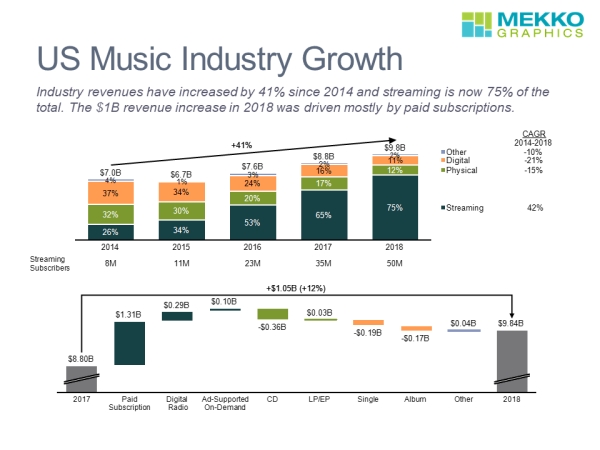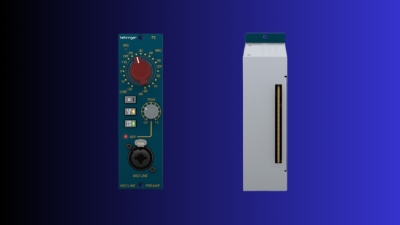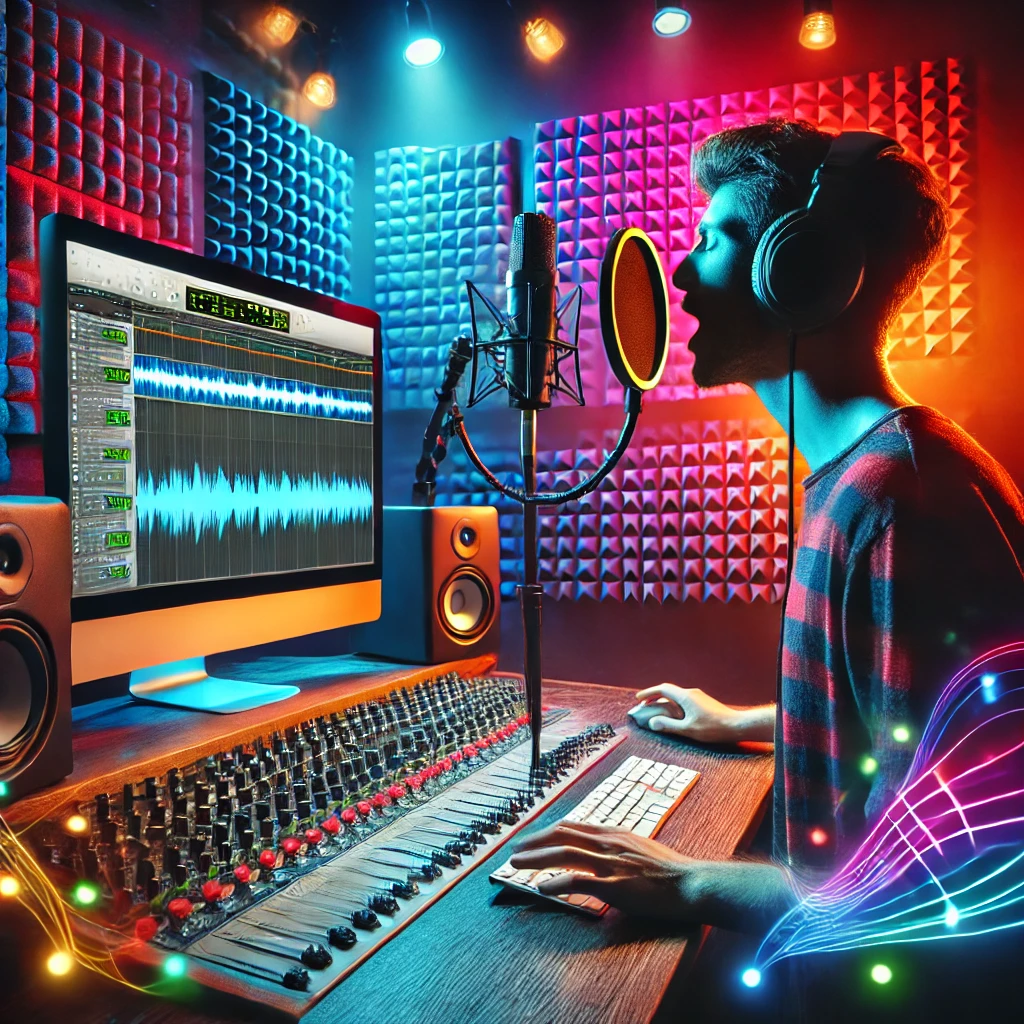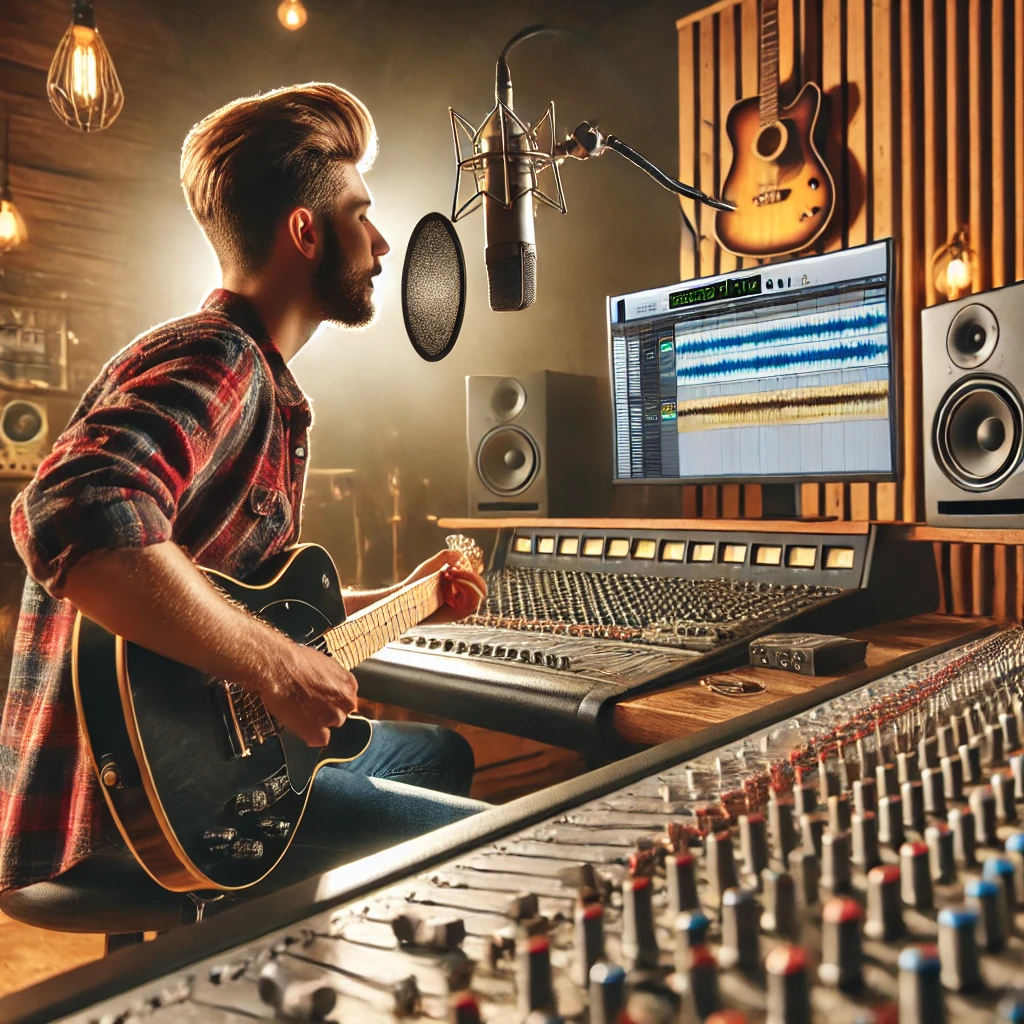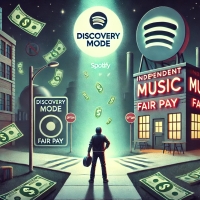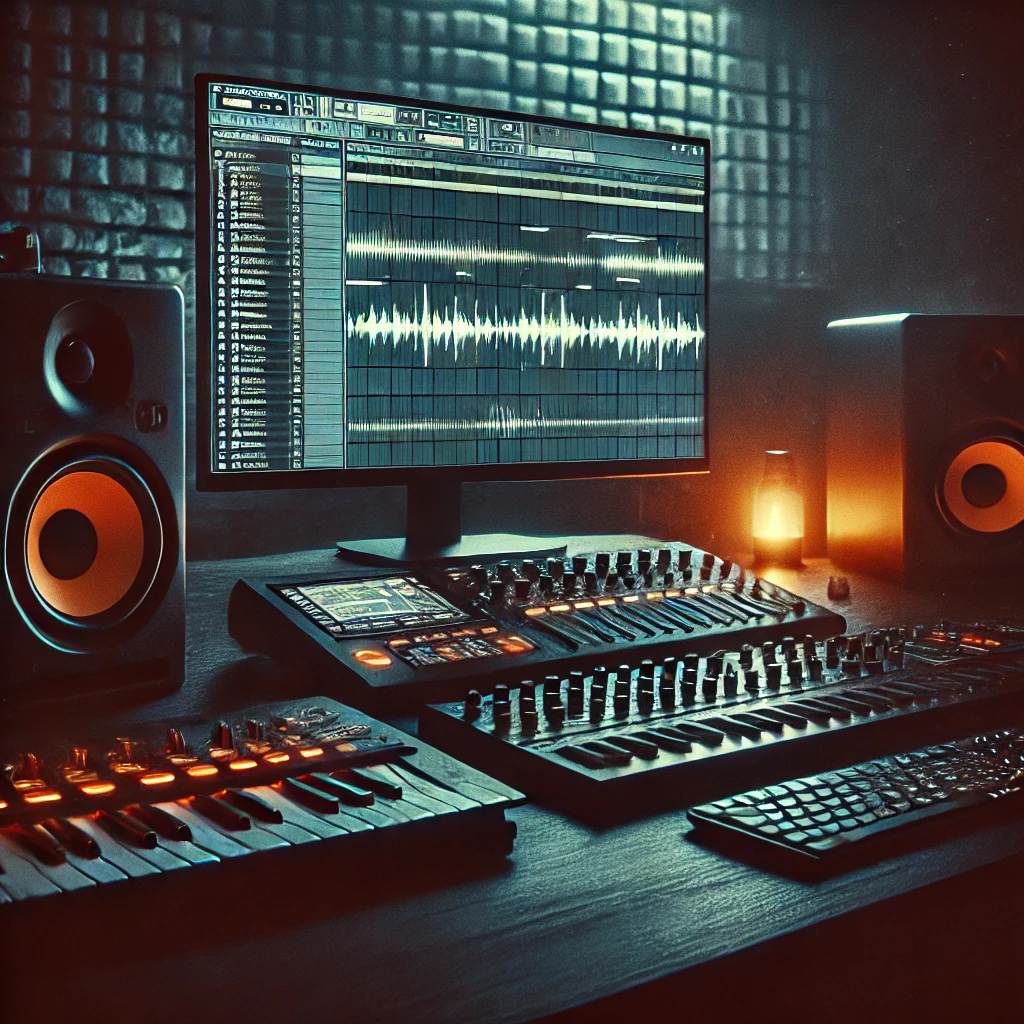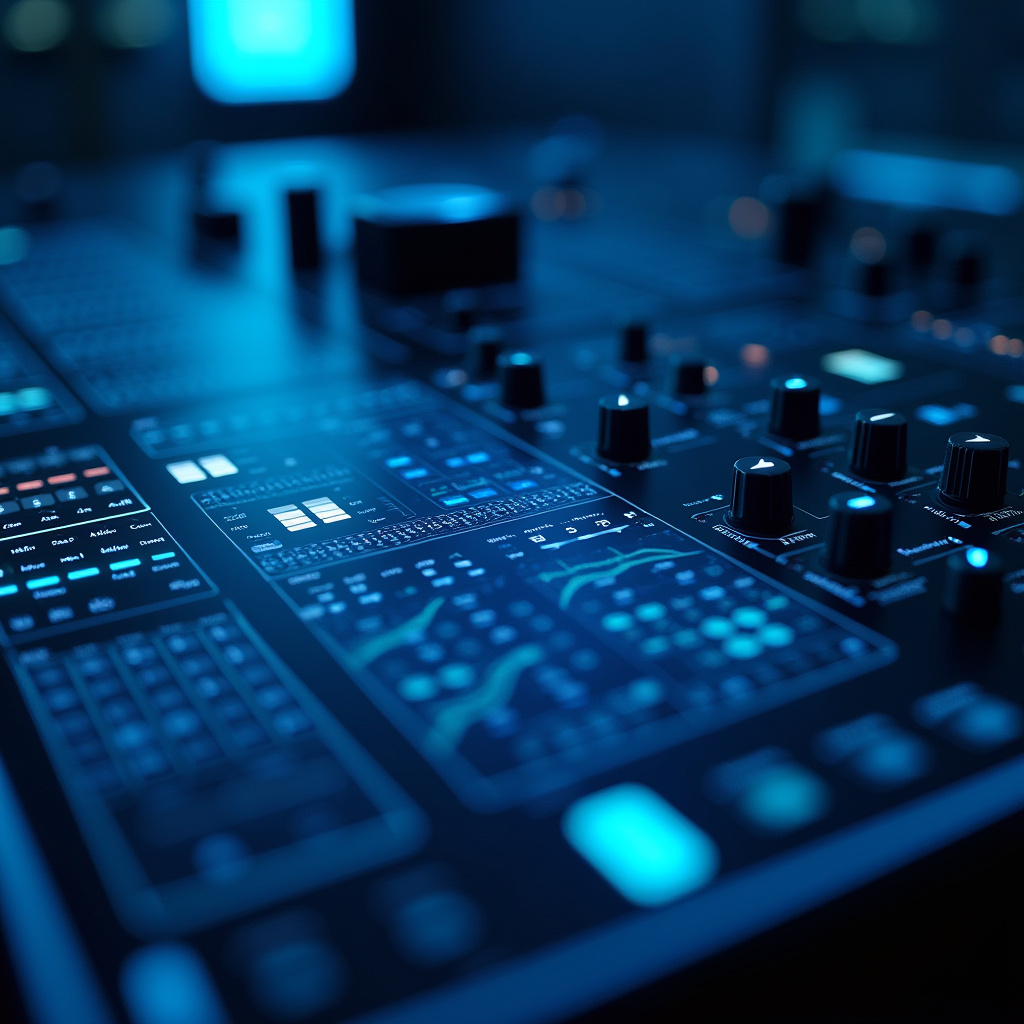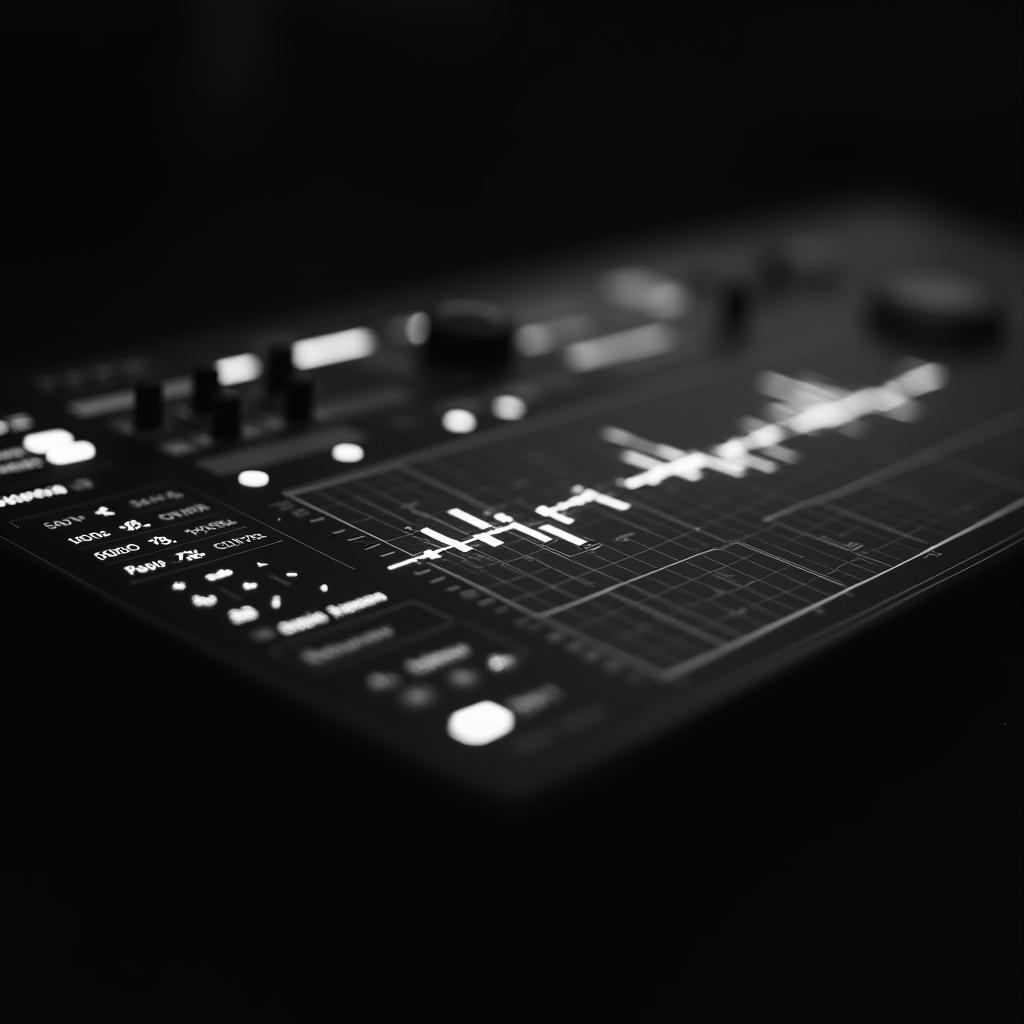
General Knowledge (85)
Playboi Carti’s MUSIC: A Chaotic Masterpiece That Redefines Modern Hip-Hop
Written by Sounds SpacePlayboi Carti’s MUSIC: A Chaotic Masterpiece That Redefines Modern Hip-Hop
In March 2025, Playboi Carti unveiled his long-awaited third studio album, MUSIC, a 30-track odyssey that defies conventional hip-hop norms. Featuring collaborations with industry heavyweights like Travis Scott, The Weeknd, Kendrick Lamar, and others, the album debuted at number one on the US Billboard 200, solidifying Carti's position as a trailblazer in the genre.
A Long-Awaited Release
The journey to MUSIC was anything but straightforward. Following the success of his 2020 album Whole Lotta Red, Carti began teasing new music as early as March 2021. Initially titled Narcissist, the project underwent several transformations before finally being announced as MUSIC in March 2025. The album's release was preceded by cryptic billboards and social media teasers, culminating in its drop on March 14, 2025. Despite delays due to sample clearance issues, the anticipation only heightened the album's impact upon release.
Commercial Triumph
MUSIC shattered streaming records, amassing 139.3 million first-day streams on Spotify, making it the biggest debut of 2025 and the seventh-largest in the platform's history. The album outperformed releases from artists like Drake and Kendrick Lamar, showcasing Carti's immense popularity.
In its first week, MUSIC earned 298,000 album-equivalent units in the U.S., marking Carti's second number-one album and his fastest-selling to date. All 30 tracks simultaneously debuted on the Billboard Hot 100, a feat unprecedented for a rapper.
Artistic Evolution
MUSIC represents a significant evolution in Carti's sound. Departing from his signature "baby voice" style, he adopts a deeper, raspier tone throughout the album. The project blends elements of trap, rage music, and experimental sounds, creating a unique auditory experience. Tracks like "Evil J0rdan" and "Mojo Jojo" exemplify this shift, showcasing Carti's willingness to push boundaries.
The album's production credits read like a who's who of the industry, featuring names like Metro Boomin, TM88, and Wheezy. Notably, DJ Swamp Izzo serves as the album's hypeman, providing a human anchor to Carti's chaotic soundscape.
Collaborations and Features
MUSIC boasts an impressive roster of guest artists, including Travis Scott, The Weeknd, Kendrick Lamar, Future, Lil Uzi Vert, and Young Thug. These collaborations add depth and variety to the album, with each artist bringing their unique flair to the project. For instance, Kendrick Lamar's contribution on "Mojo Jojo" stands out as a highlight, blending seamlessly with Carti's experimental approach.
Critical Reception
Critics have lauded MUSIC for its innovation and boldness. NME described the album as a "journey through trap’s peaks and valleys," highlighting Carti's ability to spin chaos into something cinematic.
The Guardian praised the album's exploration of diverse soundscapes, noting its blend of classic Atlantan trap, Hungarian psych, and bright R&B. They emphasized that despite a few less impactful tracks, the overall project showcases Carti's capacity to innovate and captivate.
However, not all reviews were entirely positive. Pitchfork acknowledged the album's self-indulgence and chaotic nature but recognized it as a bold statement capturing the essence of Carti's artistic vision.
Controversies and AI Accusations
Despite its success, MUSIC has not been without controversy. Some tracks, notably "Rather Lie" and "Fine Shit," faced allegations of being generated using artificial intelligence, with critics questioning the authenticity of Carti's vocals. Carti has denied these claims, asserting the originality of his work.
Deluxe Edition and Future Projects
On March 25, 2025, Carti released a deluxe edition of the album titled MUSIC – Sorry 4 Da Wait, featuring additional tracks and music videos. Looking ahead, Carti has hinted at a forthcoming project titled Baby Boi, indicating that his creative journey is far from over.
Conclusion
Playboi Carti's MUSIC is more than just an album; it's a statement of artistic evolution and a testament to his willingness to defy norms. By embracing chaos and experimentation, Carti has crafted a project that challenges listeners and redefines the boundaries of hip-hop. As he continues to innovate, Carti solidifies his position as one of the most influential artists of his generation.
In April 2025, the U.S. music industry faces significant challenges due to newly imposed tariffs, which are affecting various sectors from manufacturing to live performances. These tariffs, aimed at reshaping global trade dynamics, are having unintended consequences on the music industry, leading to increased costs, disrupted supply chains, and broader economic implications.
1. Rising Costs for Musical Instruments and Equipment
The imposition of tariffs has led to increased costs for musical instruments and equipment, many of which are manufactured or assembled overseas. Tariffs on imports from countries like Vietnam and China have disrupted specialized supply chains, making it challenging for companies to absorb the increased costs. Vietnam and China account for a significant portion of U.S. musical gear imports, and the industry warns of potential further losses.
2. Impact on Live Music and Touring
The live music sector is also feeling the effects of the tariffs. Increased costs for imported equipment such as guitars, drums, amplifiers, and sound systems are affecting independent artists and smaller venues with limited budgets. Even domestically produced equipment may be affected due to reliance on imported components.
3. Strain on Independent Retailers and Record Stores
Independent music retailers and record stores are grappling with the financial strain caused by the tariffs. The increased costs of imported goods are leading to higher prices for consumers, potentially reducing sales and threatening the viability of these businesses.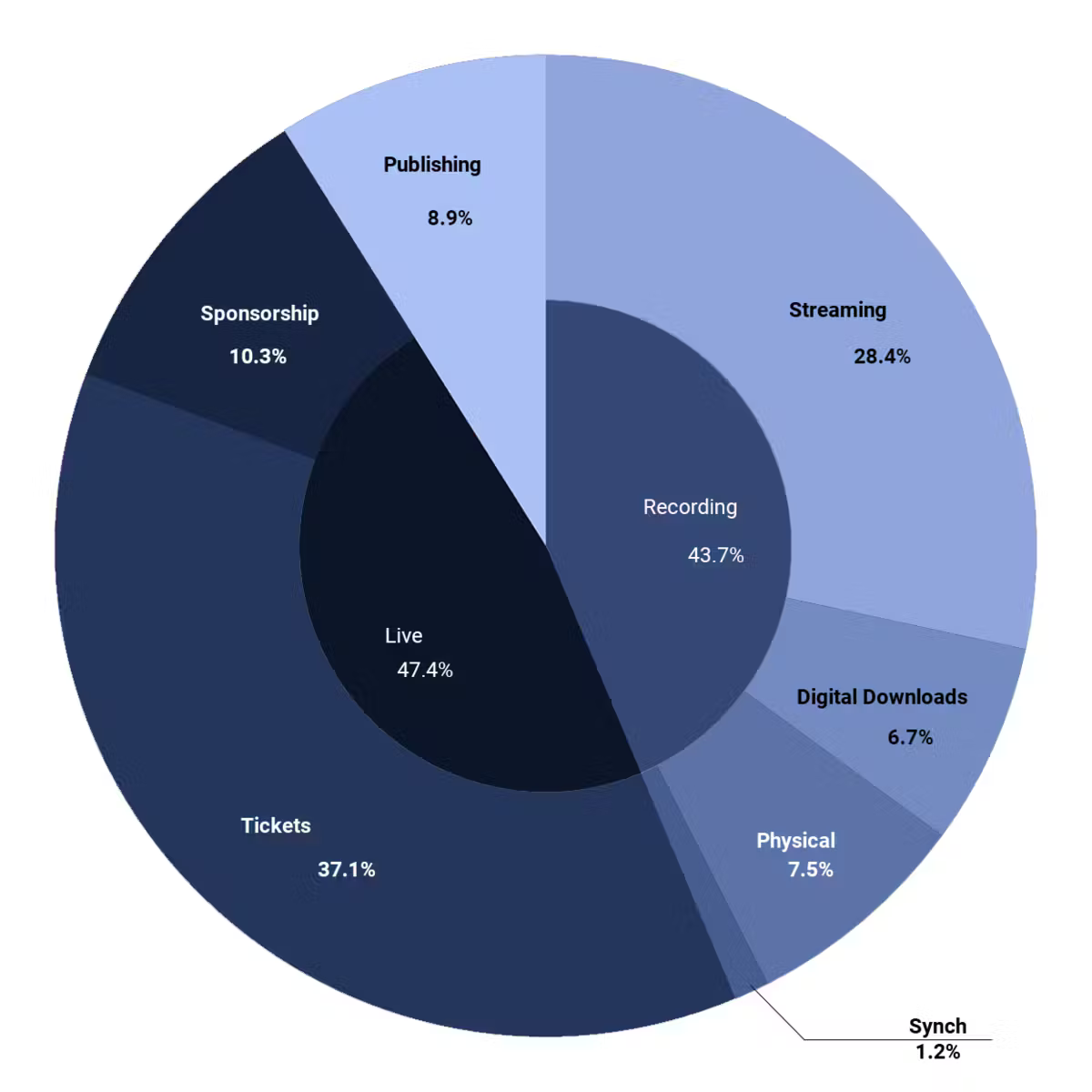
4. Broader Economic Implications
Beyond the music industry, the tariffs are contributing to broader economic challenges. Businesses across various sectors are experiencing increased costs, halted expansion plans, canceled orders, and hiring delays. The financial uncertainty and disrupted supply chains are affecting consumer demand and overall economic stability.
5. Industry Response and Advocacy
In response to the tariffs, industry organizations such as the National Association of Music Merchants (NAMM) are advocating for exemptions specific to the music products industry. They emphasize the unique supply chains of the industry and the disproportionate impact of the tariffs on manufacturers and retailers.
Conclusion
The newly imposed tariffs in 2025 are having a profound impact on the U.S. music industry, affecting everything from manufacturing and retail to live performances and broader economic stability. As the industry navigates these challenges, continued advocacy and strategic adjustments will be crucial to mitigate the adverse effects and sustain the vibrancy of the music sector.
Impact of New Tariffs on U.S. Musical Instrument Industry
Written by Sounds SpaceIn April 2025, the U.S. government, under President Donald Trump, announced a series of sweeping tariffs affecting various industries, including the musical instrument sector. These tariffs have introduced significant challenges, impacting manufacturers, retailers, and consumers alike.
Overview of the New Tariffs
On April 2, 2025, President Trump issued an executive order imposing a universal 10% import tariff on all countries, effective April 5. Additionally, targeted reciprocal tariffs ranging from 10% to 50% were introduced in 60 nations with trade deficits in the U.S. China faced a combined 54% tariff, while the European Union was subjected to a 20% tariff.
Vietnam, a significant player in the musical instrument manufacturing sector, was hit with a 46% tariff. This move was particularly impactful as many manufacturers had previously shifted production to Vietnam to mitigate earlier tariffs imposed on Chinese imports.
Immediate Impact on the Musical Instrument Industry
The National Association of Music Merchants (NAMM) expressed deep concerns over these tariffs, highlighting their potential to disrupt specialized supply chains and increase costs in an already low-margin industry. John Mlynczak, President and CEO of NAMM, stated that these tariffs could lead to significant disruptions, making it challenging for companies to absorb the increased costs.
Vietnam and China are crucial to the U.S. musical gear market, accounting for 26% and 43% of imports, respectively. The imposition of these tariffs threatens to increase prices for consumers and reduce the competitiveness of U.S. manufacturers.
Supply Chain Disruptions
The tariffs have placed unprecedented strain on global supply chains, particularly those built in Asia over decades. Companies are grappling with rising costs and limited alternatives for relocating labor-intensive manufacturing to the U.S. Shifting production to avoid tariffs is both costly and time-consuming, affecting goods like musical instruments, electronics, and furniture.
The musical instrument market is highly globalized, and tariffs on China, in particular, will hit the entry-level market—students, teenagers, and cash-strapped school music programs—the hardest.
Industry Response and Advocacy
In response to the tariffs, NAMM has been actively advocating for exemptions specific to the music products industry. The organization emphasized that the unique supply chains of the music products industry are unfairly impacted, with China and Vietnam accounting for a significant share of imports. NAMM continues to urge the administration to exempt musical instruments and accessories from these measures to safeguard American manufacturers and sustain the competitiveness of the industry.
Furthermore, U.S. and Vietnamese businesses have jointly requested a delay in the implementation of the 46% tariff on Vietnamese goods, citing concerns over the potential harm to bilateral commercial relations.
Economic Implications
The announcement of these tariffs led to significant market volatility. Wall Street experienced its worst trading day since the COVID-19 pandemic in 2020, with the S&P 500 plunging 4.9%, erasing $2.5 trillion in value. The Nasdaq led losses with a 5.9% drop due to heavy tech stock declines. The universal 10% tariff, complemented by reciprocal levies, startled investors and raised fears of a potential recession.
Analysts projected weakened U.S. growth and rising inflation, risking a scenario of stagflation. Global leaders, particularly from the EU, UK, and Canada, condemned the tariffs, pledging potential countermeasures.
Potential Price Increases for Consumers
The tariffs are expected to lead to higher prices for musical instruments and related equipment. Reports indicate that prices could soar by 25% or more, affecting everything from brand-new imports to American-made instruments and even the secondhand market. This has both musicians and retailers concerned, with some urging buyers to make purchases before costs climb.
Sweetwater, a prominent musical instrument retailer, anticipates that some prices will increase as much as 25% in the coming months.
Broader Industry Concerns
The music industry at large is feeling the ripple effects of the tariffs. Shares in major music companies have been hit hard, with iHeartMedia's shares falling more than 13%, Cumulus Media down over 10%, and SiriusXM also affected.
The live music industry is also reeling, with warnings of long-term damage to an already fragile music economy.
Government Negotiations and Temporary Reprieves
In a dramatic policy reversal, President Trump announced a temporary reduction in newly imposed tariffs on numerous countries, triggering a significant global stock market rally. While maintaining a tough stance on China by increasing tariffs on Chinese imports to 125%, he introduced a 90-day freeze on other country-specific tariffs.
Additionally, the U.S. and Vietnam agreed to start trade deal talks as tariffs were paused, indicating a potential for negotiated resolutions that could alleviate some of the pressures on the musical instrument industry.
Conclusion
The imposition of new tariffs in April 2025 has introduced significant challenges for the U.S. musical instrument industry, affecting manufacturers, retailers, and consumers. The potential for increased prices, supply chain disruptions, and economic volatility underscores the need for
How to Beat the Spotify Algorithm and Skyrocket Your Streams
Written by Sounds SpaceHow to Beat the Spotify Algorithm and Skyrocket Your Streams
Spotify’s algorithm is a mysterious force that can either make or break your music career. If you understand how it works, you can leverage it to grow your audience, increase streams, and land on algorithmic playlists. If you ignore it, your music could remain undiscovered, lost in the vast sea of content.
In this guide, we’ll break down how Spotify’s algorithm functions and give you actionable steps to optimize your releases, boost engagement, and ultimately beat the system to get your music heard by the right audience.
Understanding the Spotify Algorithm
Spotify's recommendation system is powered by a combination of AI, user behavior tracking, and playlist curation. The algorithm primarily analyzes three key engagement metrics:
-
User Interaction Metrics – How listeners engage with your tracks (skips, saves, repeats, playlist adds, etc.).
-
Listening History – What songs users have listened to and how often.
-
Contextual Playlists – Whether your music fits into curated and algorithmic playlists like Discover Weekly and Release Radar.
Spotify’s goal is to keep listeners engaged, and the algorithm rewards artists who can consistently keep people listening to their music.
Step 1: Optimize Your Spotify Profile
Before you even think about hacking the algorithm, make sure your artist profile is in top shape. Here’s what you need to do:
-
Claim Your Spotify for Artists Profile – This gives you access to analytics and the ability to customize your page.
-
Upload High-Quality Images – Professional branding makes you look serious.
-
Write a Compelling Bio – Include keywords related to your genre, influences, and a call-to-action for fans.
-
Add Social Links – Direct people to your Instagram, TikTok, YouTube, and website.
-
Keep Your Artist Pick Updated – This is a great way to promote your latest release.
Step 2: Release Music Consistently
The algorithm favors artists who release music frequently. Instead of dropping an album every year, consider releasing singles every 4-6 weeks. This helps you:
-
Stay on Spotify’s radar.
-
Get more chances to be featured on Release Radar.
-
Keep fans engaged with fresh content.
Step 3: Get Playlist Placements
Playlists drive a massive portion of Spotify streams. Here’s how to land on more of them:
Submit to Spotify Editorial Playlists
Use Spotify for Artists to pitch your track at least 2 weeks before release. Provide detailed info about the song’s mood, genre, and instruments used.
Target Independent Playlists
Reach out to playlist curators on Instagram, Twitter, or SubmitHub. Find playlists that match your genre and ask for placements.
Encourage User-Generated Playlists
Ask fans to add your songs to their personal playlists. More user-generated adds boost your chances of being picked up by algorithmic playlists.
Step 4: Encourage Saves, Shares, and Repeat Plays
Spotify tracks how listeners interact with your song. The more people save, share, and replay your tracks, the better the algorithm will treat you.
Tips to Boost Engagement:
-
Ask Fans to Save Your Track – Run contests or giveaways to encourage this.
-
Get on TikTok – Viral TikTok sounds translate to Spotify plays.
-
Use Instagram Stories – Share Spotify links and encourage fans to repost.
-
Create Challenges or Trends – Get people to use your music in reels or TikTok videos.
Step 5: Promote Pre-Saves Before Release
Pre-saves signal to Spotify that people are anticipating your release. More pre-saves = higher chances of being featured on Release Radar and other playlists.
How to Get More Pre-Saves:
-
Run a contest where fans must pre-save to enter.
-
Use a landing page (via Hypeddit, Feature.fm, etc.) to track pre-saves.
-
Promote on social media and email lists.
Step 6: Drive External Traffic to Spotify
Spotify loves when artists bring in listeners from outside the platform. This increases your credibility and signals that people care about your music.
Ways to Drive External Traffic:
-
YouTube & Shorts – Post teasers, lyric videos, and behind-the-scenes content.
-
Instagram & TikTok – Create viral trends around your songs.
-
Twitter & Reddit – Engage in music discussions and share your links.
-
Email Marketing – Build a fanbase and send direct links to your music.
Step 7: Collaborate with Other Artists
Featuring or collaborating with another artist exposes you to their audience, leading to more streams and engagement. Cross-promoting a release can introduce your music to new fans.
Step 8: Analyze and Adjust Your Strategy
Use Spotify for Artists to track your progress. Key metrics to monitor:
-
Stream Count – Are your numbers increasing?
-
Listener Retention – Are people skipping your tracks or playing them repeatedly?
-
Playlist Adds – How many playlists have featured your song?
-
Geographic Data – Where are your listeners coming from?
If a track is underperforming, adjust your promotion strategy and try again.
Conclusion: Work with the Algorithm, Not Against It
The key to beating the Spotify algorithm is consistent engagement. Release music frequently, encourage interaction, drive traffic, and optimize your profile. By following these steps, you’ll increase your chances of landing on playlists, boosting your streams, and building a sustainable music career.
Now it’s time to put these strategies into action! Stay consistent, experiment with promotion tactics, and watch your Spotify numbers grow. 🚀
The SHOCKING Behringer NEVE 1073 Preamp We HAVE to Talk About
Written by Sounds SpaceIn the realm of audio recording, certain pieces of equipment have achieved legendary status, shaping the sound of countless iconic tracks and albums. One such piece is the Neve 1073 microphone preamplifier, renowned for its rich, warm sound and distinctive 3-band EQ. Introduced in the 1970s, the Neve 1073 quickly became a staple in studios like Abbey Road and Sound City, contributing to the sonic character of artists ranging from Led Zeppelin to The Who.
Given the 1073's esteemed reputation, it's no surprise that many manufacturers have sought to recreate its magic. Among these, Behringer's 1273 microphone preamplifier stands out as a noteworthy homage to the classic Neve design. Developed in collaboration with John Price, an engineer who worked alongside Rupert Neve himself, the 1273 aims to capture the essence of the original while integrating features suited for modern production environments.
Design and Features
The Behringer 1273 is a dual-channel microphone preamplifier that mirrors the aesthetic and functional design of the original Neve 1073. Each channel offers up to 80 dB of gain, adjustable via resistor-stepped rotary switches, ensuring precise control over input levels. A notable addition is the "Tone" switch, which adjusts the transformer's impedance to optimize performance for different microphone types, such as dynamic or ribbon mics.
The preamp features a 3-band EQ section with selectable frequency bands:
-
Low-shelf frequencies at 35, 60, 110, and 220 Hz
-
Midrange frequencies at 360, 700, 1600, 3200, 4800, and 7200 Hz
-
High-shelf frequencies at 10, 12, and 16 kHz
Additionally, a high-pass filter offers cutoff points at 50, 80, 160, and 300 Hz, allowing users to eliminate unwanted low-frequency rumble. The EQ section can be bypassed entirely, providing flexibility for those who prefer to use external processors.
Connectivity is robust, with transformer-balanced inputs and outputs, XLR combo jacks, and dedicated insert points for integrating outboard gear such as compressors or additional EQ units. Each channel also includes dedicated Phase, Insert, Line, Instrument, Tone, and 48V phantom power switches, enhancing versatility in various recording scenarios. citeturn0search4
Sound Quality
At the heart of the 1273's sonic character are its all-discrete Class A circuitry and custom-built Midas input and output transformers. These components are designed to deliver the warm, harmonically rich sound that made the original 1073 so sought after. Users have noted that the 1273 effectively captures the "Neve-like" flavor, providing a pleasing coloration that enhances vocals, guitars, and other instruments.
The EQ section offers musical and responsive control, allowing engineers to sculpt tones effectively without introducing harshness. The high-pass filter is particularly useful for cleaning up low-end muddiness, making the 1273 suitable for a wide range of applications, from tracking to mixing.
User Experience
In terms of build quality, the 1273 features a sturdy 2U rackmount enclosure with vintage-style knobs and switches that evoke the classic British aesthetic. While some users have reported that the knobs feel less robust compared to higher-priced units, the overall construction is solid, especially considering its price point.
The front panel layout is intuitive, with clear labeling and a logical arrangement of controls. The inclusion of front-panel instrument inputs and XLR combo jacks enhances convenience, allowing for quick connections during sessions. High-visibility LED signal meters provide immediate feedback on input levels, aiding in precise gain staging.
Comparisons and Market Position
The Behringer 1273 enters a market populated with various Neve 1073 clones and inspired units, ranging from high-end replicas to more affordable alternatives. Its competitive pricing—listed at £575—positions it as an accessible option for home studios and project studios seeking the classic Neve sound without the hefty investment
While it may not match the exacting standards of premium replicas or the original unit, the 1273 offers a commendable balance of quality and affordability. Its collaboration with an original Neve engineer lends credibility to its design, and the inclusion of modern features enhances its appeal to contemporary users.
Conclusion
The Behringer 1273 stands as a testament to the enduring legacy of the Neve 1073, bringing its celebrated sound within reach of a broader audience. By combining classic design elements with thoughtful modern enhancements, Behringer has created a preamplifier that honors its inspiration while catering to the needs of today's recording environments. For those seeking the warmth and musicality of the original 1073 without breaking the bank, the 1273 presents a compelling option worthy of consideration.
Spotify’s Latest Changes: A Game-Changer for Musicians or a Setback?
Written by Sounds SpaceSpotify, as a leading music streaming platform, has recently implemented several updates aimed at refining its royalty distribution system and addressing challenges within the music industry. These changes are designed to combat artificial streaming, ensure fair compensation, and enhance the overall experience for both artists and listeners. However, they have elicited mixed reactions from the artist community, with potential benefits and drawbacks.
Combatting Artificial Streaming
Artificial streaming, where bots or click-farms are used to inflate play counts, has been a persistent issue, diverting royalties away from genuine artists. To address this, Spotify has introduced measures to detect and penalize such fraudulent activities. Starting in early 2024, labels and distributors will be charged per track when flagrant artificial streaming is detected on their content. This initiative aims to deter bad actors and ensure that royalties are directed to hardworking, legitimate artists.
Positive Impact: By reducing fraudulent streams, more revenue can flow to authentic artists, enhancing the integrity of the platform.
Negative Impact: Smaller labels and independent artists might face challenges if falsely accused of artificial streaming, potentially leading to disputes and financial strains.
Minimum Stream Threshold for Royalty Eligibility
In an effort to allocate royalties more effectively, Spotify has set a new policy requiring tracks to achieve at least 1,000 streams in the previous 12 months to qualify for royalty payments. This change, effective from April 2024, aims to redirect funds from underperforming tracks to those with higher engagement.
Positive Impact: This policy could increase earnings for more popular tracks, ensuring that active artists receive a larger share of the royalty pool.
Negative Impact: Emerging and niche artists may find it challenging to reach the 1,000-stream threshold, potentially resulting in lost income and discouragement. Critics argue that this approach undervalues the artistic contributions of lesser-known musicians.
Adjustments to Functional Noise Recordings
Spotify has also revised its policies regarding functional genres, such as white noise and nature sounds. Tracks in these categories must now be at least two minutes long to be eligible for royalties, and their valuation will be adjusted to reflect their content better. This move addresses concerns about the proliferation of short, repetitive noise tracks designed to game the streaming system.

Positive Impact: By curbing exploitative practices, Spotify aims to maintain a fairer environment where genuine musical content is prioritized and rewarded appropriately.
Negative Impact: Artists specializing in functional audio may need to adapt their content strategies, potentially affecting their creative output and revenue streams.
Introduction of Discovery Mode
Spotify's Discovery Mode, introduced in 2020, allows artists to agree to lower royalty rates in exchange for increased algorithmic promotion. While this can enhance visibility, it has drawn criticism for its lack of transparency and potential to favor larger labels over independent artists. Some view it as reminiscent of the controversial "payola" practices, raising ethical concerns within the industry.
Positive Impact: Artists willing to participate may experience greater exposure and audience growth, potentially leading to increased engagement and opportunities.
Negative Impact: The reduction in royalty rates and potential inequities in promotion could disadvantage independent artists, exacerbating existing disparities in the music industry.
Financial Milestones and Artist Compensation
In 2024, Spotify announced it had paid a record $10 billion in royalties, representing two-thirds of its total revenue. Despite this significant payout, only about 4% of artists on the platform can expect to earn a sustainable income from their work. This disparity highlights ongoing concerns about the adequacy of streaming compensation for the majority of musicians.
Positive Impact: The substantial total royalties indicate Spotify's growing financial contributions to the music industry, benefiting top-performing artists and rights holders.
Negative Impact: The vast majority of artists receive minimal compensation, underscoring the challenges of achieving financial sustainability through streaming alone.
Use of 'Ghost Artists' and Playlist Practices
Investigations have revealed Spotify's use of "ghost artists"—fabricated profiles created to supply music for popular playlists. This practice allows Spotify to reduce royalty payouts but raises ethical questions about transparency and the impact on genuine artists seeking exposure.
Positive Impact: From a business perspective, this strategy may reduce costs and offer a vast library of content for users.
Negative Impact: It potentially undermines authentic artists by diverting attention and royalties away from genuine creative works, affecting their visibility and income.
Global Reach and Opportunities
Federica Tremolada, Spotify's managing director for Europe, emphasizes that streaming has revitalized the music industry by enabling artists to reach global audiences. Spotify's integration of podcasts and audiobooks, along with AI-driven personalization tools like Daylist and AI DJ, offers artists new avenues to connect with listeners worldwide.
Positive Impact: Artists have unprecedented opportunities to expand their reach and engage with diverse audiences, potentially leading to increased recognition and fan bases.
Negative Impact: The vastness of the platform can make it challenging for individual artists to stand out, necessitating additional marketing efforts and resources.
Conclusion
Spotify's recent updates reflect its ongoing efforts to balance innovation, fairness, and profitability in the evolving music streaming landscape. While these changes aim to address critical issues like artificial streaming and equitable compensation, they also present challenges, particularly for independent and emerging artists. As the platform continues to evolve, it is imperative for Spotify to engage with the artist community, ensuring that its policies support a diverse and vibrant musical ecosystem.
How to Create the Best Type of Content for Musicians to Achieve the Popularity They Desire
Written by Sounds SpaceHow to Create the Best Type of Content for Musicians to Achieve the Popularity They Desire
In today's digital world, a musician’s success is no longer just about talent. Creating engaging content is essential to building a fan base, attracting industry attention, and ultimately achieving the popularity every artist desires. Whether you're an independent artist or signed to a label, knowing how to craft the right type of content can make all the difference in your music career.
This guide will break down the most effective content strategies musicians can use to maximize their reach, engage with their audience, and establish a strong personal brand.
1. The Power of Visual Content: Music Videos & Short Clips
Music is an auditory experience, but visuals play a significant role in captivating an audience. Here are two key types of visual content that musicians should focus on:
Music Videos
A high-quality music video can bring a song to life and help establish an artist’s brand. To create an effective music video:
- Tell a story that complements the song’s message.
- Use high-quality visuals and professional editing.
- Consider using unique locations and creative cinematography to stand out.
- Upload your music videos to YouTube, Vevo, and social media platforms for maximum exposure.
Short-Form Video Content (TikTok, Reels, Shorts)
With platforms like TikTok, Instagram Reels, and YouTube Shorts dominating the social media space, short-form video content is essential for musicians. Tips for creating viral short videos:
- Showcase behind-the-scenes moments of your music production.
- Create engaging challenges or trends related to your song.
- Post snippets of upcoming releases to build anticipation.
- Encourage fans to use your music in their own videos.
2. Social Media Content: Building a Loyal Fanbase
Social media is a powerful tool for musicians to connect with fans. Each platform serves a different purpose, so it's crucial to create content tailored to each one:
Instagram & Facebook
- Post high-quality photos from gigs, studio sessions, and daily life.
- Utilize Stories and live streaming to connect with fans in real time.
- Use carousel posts to tell a story (e.g., the making of a song or album).
Twitter/X
- Share thoughts on music, industry news, and personal insights.
- Engage with fans by replying to comments and tweets.
- Post teaser announcements for new releases.
TikTok & YouTube Shorts
- Create viral challenges using your own music.
- Collaborate with influencers to promote your tracks.
- Post tutorials or breakdowns of your song’s production process.
YouTube
- Upload vlogs showcasing your journey as an artist.
- Share behind-the-scenes footage from music videos or recording sessions.
- Create reaction or commentary videos to engage fans on a deeper level.
3. Engaging Storytelling: Personal Branding Through Content
Your personal brand is what makes you unique as an artist. Storytelling is a powerful way to create emotional connections with your audience. Here’s how to incorporate storytelling into your content:
- Artist Journey Content – Share your struggles, triumphs, and experiences in the music industry.
- Inspirational Stories – Talk about what inspired your music and the meaning behind your lyrics.
- Fan Engagement – Share user-generated content and respond to fan comments to create a sense of community.
4. Leveraging Streaming Platforms for Maximum Exposure
Streaming services like Spotify, Apple Music, and SoundCloud are crucial for gaining exposure. Here’s how to optimize your presence on these platforms:
- Playlist Placement – Submit your music to curated playlists for better discoverability.
- Spotify Canvas – Use engaging visuals in Spotify’s Canvas feature to make your songs stand out.
- Pre-Save Campaigns – Encourage fans to pre-save your songs before they drop to boost initial streaming numbers.
- Share Playlists – Create and share playlists that include your own songs along with similar artists to introduce your music to new audiences.
5. Consistency & Content Scheduling
To keep fans engaged, it's important to maintain a consistent content schedule. Use a content calendar to plan out posts and releases. Best practices include:
- Posting new content at least 3-4 times a week.
- Aligning content with major music releases or events.
- Repurposing content across different platforms (e.g., turning a TikTok snippet into an Instagram Reel).
6. Live Streaming & Virtual Concerts
Live streaming has become one of the most effective ways for musicians to engage with their audience in real time. Platforms like Twitch, Instagram Live, Facebook Live, and YouTube Live allow artists to:
- Perform acoustic or stripped-down versions of their songs.
- Host Q&A sessions with fans.
- Share exclusive content, such as unreleased tracks.
- Collaborate with other artists through joint livestreams.
7. Email Marketing & Direct Fan Engagement
While social media is great for engagement, email marketing allows for more direct and personal communication with fans. Strategies include:
- Offering exclusive content or early access to new releases.
- Sending regular newsletters with updates on your music journey.
- Providing special promotions for concert tickets or merchandise.
8. Collaborations & Networking
Collaborating with other musicians, influencers, or content creators can significantly expand your reach. Consider:
- Featuring on other artists' tracks or remixes.
- Creating duet or reaction videos on social media.
- Partnering with brands for sponsored content that aligns with your image.
9. Behind-the-Scenes & Documentary-Style Content
Fans love seeing the real and raw side of an artist. Document your music-making process with:
- Studio session vlogs.
- Songwriting breakdowns.
- Behind-the-scenes footage from music videos or tours.
10. Engaging with Trends & Challenges
Stay up-to-date with social media trends and participate in viral challenges to keep your content fresh. Some ways to do this include:
- Using trending hashtags and sounds.
- Engaging with fan-made content by resharing it.
- Creating your own challenge using your latest single.
Conclusion
Creating high-quality content is just as important as making great music. By leveraging social media, video content, streaming platforms, and direct engagement strategies, musicians can build a loyal fanbase and achieve the popularity they desire. The key is consistency, creativity, and authenticity—fans connect with artists who share their real stories and emotions.
If you're an artist looking to boost your online presence, start implementing these content strategies today and watch your fanbase grow!
How to Write a Catchy Song Every Time You Are in the Studio
Written by Sounds SpaceHow to Write a Catchy Song Every Time You Are in the Studio
Creating a catchy song isn’t just about luck—it’s about having the right strategies, mindset, and techniques to consistently deliver great music. Whether you’re a seasoned songwriter or just getting started, stepping into the studio with a solid approach will increase your chances of crafting a memorable hit.
This blog will guide you through the essential elements of writing a catchy song every time you enter the studio.
1. Start With a Strong Concept
Every great song starts with a compelling idea. Before you even touch an instrument or write lyrics, spend some time brainstorming a strong concept. Ask yourself:
- What story do I want to tell?
- What emotion do I want to evoke?
- What’s a unique angle or theme I can explore?
Some of the most successful songs revolve around universal themes like love, heartbreak, empowerment, or celebration. However, the key is to find a fresh way to approach these ideas.
Pro Tip: Keep a notebook or use your phone to jot down interesting phrases, emotions, or experiences that could serve as song ideas.
2. Find the Perfect Hook
The hook is the most memorable part of your song. It’s the melody or phrase that sticks in people’s heads long after they’ve heard it. A strong hook is:
- Simple and easy to remember
- Catchy and repetitive without being boring
- Emotionally engaging
Some of the best hooks are built around short, impactful phrases like:
- "I can’t stop loving you"
- "Shake it off"
- "All you need is love"
Experiment with melodies and lyrics until you find one that resonates instantly.
Pro Tip: Play your hook for friends or fellow musicians and see if they hum it back to you after just one listen.
3. Craft a Strong Melody
A song’s melody is just as important as its lyrics. To make your melody stand out:
- Use a combination of stepwise motion and leaps to create an engaging flow
- Balance repetition with variation
- Ensure the melody complements the emotional tone of the song
Some classic songwriting techniques for crafting melodies include:
- Call and Response: Create a phrase that is answered by another phrase.
- Ascending and Descending Lines: Build tension and resolution in your melody.
- Rhythmic Catchiness: Experiment with syncopation or unexpected note placement to make it unique.
Pro Tip: Sing your melody acapella and see if it still holds its power without any instrumentation.
4. Write Meaningful and Relatable Lyrics
Lyrics can make or break a song. They should be:
- Simple yet powerful
- Emotionally honest
- Universal but with a personal touch
Here are some approaches to writing great lyrics:
- Use vivid imagery – Instead of saying "I’m sad," paint a picture: "Raindrops on my window, drowning out your name."
- Tell a story – Take listeners on a journey with a beginning, middle, and end.
- Keep it conversational – Write lyrics that sound natural when sung.
Pro Tip: Read your lyrics out loud. If they sound unnatural or forced, rewrite them until they flow effortlessly.
5. Develop a Strong Chord Progression
Great songs often have chord progressions that evoke emotion and drive the song forward. Some classic progressions that have been used in countless hits include:
- I–V–vi–IV (C–G–Am–F) – Used in songs like "Let It Be" (The Beatles)
- vi–IV–I–V (Am–F–C–G) – Heard in "Someone Like You" (Adele)
- I–IV–V–I (C–F–G–C) – Found in blues and rock classics
While these are popular, don’t be afraid to experiment and create something fresh!
Pro Tip: Try different inversions or substitute chords to add uniqueness to your progression.
6. Structure Your Song for Maximum Impact
A strong song structure helps listeners stay engaged. The most common song structures include:
- Verse–Chorus–Verse–Chorus–Bridge–Chorus (Most pop songs)
- Verse–Pre-Chorus–Chorus–Verse–Pre-Chorus–Chorus–Bridge–Chorus
- ABAB (Alternate between two sections, like in folk and indie music)
The key is to make your song dynamic. If every section sounds the same, listeners may lose interest.
Pro Tip: If your song feels repetitive, change the instrumentation or melody slightly in the second verse to keep things interesting.
7. Use Unique Production Elements
Even the best-written song can fall flat without the right production. In the studio, consider:
- Layering harmonies to add depth
- Using interesting sound effects to make your track stand out
- Experimenting with different instruments or synths
Pro Tip: Listen to your favorite songs and analyze what production tricks they use to keep listeners engaged.
8. Create a Memorable Intro and Outro
The first few seconds of your song are crucial. A strong intro will:
- Set the mood
- Capture attention immediately
- Give listeners a hint of what’s to come
Similarly, your outro should leave a lasting impression. It can fade out, resolve smoothly, or end on a dramatic note.
Pro Tip: Try looping your song’s main hook subtly in the intro to create familiarity right away.
9. Collaborate and Get Feedback
Two heads are often better than one. Collaboration can:
- Bring fresh ideas to your song
- Help refine weak points
- Introduce new perspectives
Play your song for trusted friends, producers, or fellow musicians and be open to constructive feedback.
Pro Tip: If something doesn’t feel right in your song, it probably needs tweaking. Trust your instincts!
10. Trust the Process and Have Fun
Finally, remember that songwriting should be an enjoyable experience. If you’re feeling stuck:
- Take a break and come back later
- Experiment with different sounds and lyrics
- Keep a relaxed mindset—great ideas often come when you least expect them
Pro Tip: Some of the biggest hits were written in just a few minutes, while others took months. Every song has its own journey, so be patient!
Conclusion
Writing a catchy song every time you step into the studio is possible when you follow the right approach. By starting with a strong concept, crafting a memorable hook, developing a powerful melody, and paying attention to production, you can create music that resonates with listeners.
Most importantly, trust your creativity, keep refining your craft, and enjoy the process. The more you practice, the more effortlessly catchy songs will flow out of you.
Now, go hit the studio and start creating your next hit!
How to Stay Relevant in the Music Industry as Trends and Genres Evolve
Written by Sounds SpaceHow to Stay Relevant in the Music Industry as Trends and Genres Evolve
The music industry is an ever-changing landscape. New genres emerge, old styles evolve, and audience preferences shift with time. Staying relevant in the industry requires adaptability, awareness, and a deep connection with your audience. Whether you are an artist, producer, or music entrepreneur, you must be willing to embrace change and reinvent yourself when necessary.
In this blog, we will explore key strategies to ensure your longevity and success in the music industry despite the constant evolution of trends and genres.
1. Stay Updated with Industry Trends
Music trends shift rapidly, and staying informed is crucial. Here are a few ways to keep up:
- Follow Streaming Charts: Platforms like Spotify, Apple Music, and YouTube give insights into what’s trending.
- Watch Social Media Trends: TikTok, Instagram Reels, and YouTube Shorts often drive viral songs and emerging genres.
- Follow Influential Playlists & DJs: Playlists on Spotify and Apple Music can signal the next big wave in music.
- Attend Industry Conferences & Seminars: Events like SXSW, MIDEM, and Billboard Music Conferences provide knowledge on emerging trends.
- Engage with Music Blogs & Publications: Websites like Pitchfork, Rolling Stone, and Complex report on the latest industry movements.
2. Experiment with Your Sound While Staying True to Your Identity
While it's important to evolve, maintaining a signature sound is equally vital. The most successful artists balance innovation with consistency. Consider the following:
- Analyze Your Core Strengths: Identify what makes your music unique and incorporate fresh elements without losing your essence.
- Explore Different Influences: Borrow from various genres while keeping your identity intact.
- Collaborate with Artists from Different Styles: Working with musicians from other genres helps you expand your reach while staying relevant.
- Release Alternate Versions of Songs: Acoustic, remixed, or reimagined versions can introduce your music to different audiences.
3. Leverage Digital Marketing & Social Media
A strong digital presence is non-negotiable. Here’s how you can maximize your reach:
- Engage with Fans on Social Media: Be active on Instagram, TikTok, Twitter, and Facebook to maintain a direct connection with your audience.
- Post Consistently: Regular updates, music snippets, and behind-the-scenes content help keep fans engaged.
- Utilize Short-Form Video Platforms: TikTok and Instagram Reels are key platforms for music discovery today.
- Stay Authentic in Your Branding: Let your audience connect with your personality, not just your music.
- Use Paid Advertising: Facebook Ads, Instagram Ads, and YouTube promotions can expand your audience reach significantly.
4. Adapt to New Technology and Distribution Methods
Music distribution has evolved drastically, and staying ahead means embracing technology:
- Explore NFTs and Blockchain Technology: Digital collectibles and exclusive NFT music drops can create additional revenue streams.
- Utilize AI for Marketing & Production: AI-powered tools like LANDR for mastering and ChatGPT for marketing can boost efficiency.
- Distribute Music on Multiple Platforms: Ensure your music is available on all major streaming platforms, from Spotify to Audiomack.
- Optimize for Playlists: Getting placed on major playlists can skyrocket your visibility and streams.
5. Build a Strong Brand and Diversify Your Revenue Streams
Artists today are more than just musicians; they are brands. Building a strong brand ensures longevity and multiple income sources:
- Merchandising: Sell branded merchandise like clothing, vinyl, and collectibles.
- Live Performances & Virtual Concerts: Traditional touring is great, but virtual concerts also offer opportunities for global reach.
- Sponsorships & Endorsements: Partner with brands that align with your image.
- Licensing & Sync Deals: Get your music placed in movies, TV shows, and advertisements.
- Patreon & Fan Subscriptions: Create exclusive content for dedicated fans who are willing to support your journey.
6. Network and Build Strong Industry Relationships
Success in the music industry isn’t just about talent—it’s also about relationships. Here’s how to build connections:
- Collaborate with Other Artists and Producers: Feature other artists on your tracks and work on joint projects.
- Engage with Industry Professionals: A&Rs, playlist curators, managers, and promoters can play a crucial role in your success.
- Attend Music Conferences & Local Events: Physical presence at industry events builds stronger bonds than virtual connections.
- Use LinkedIn & Other Professional Platforms: Connect with professionals in the industry through LinkedIn and other networking sites.
7. Stay Consistent and Keep Releasing Music
No matter how much the industry changes, consistency remains key. Staying relevant means being active:
- Maintain a Regular Release Schedule: Whether it’s singles, EPs, or albums, keep your audience engaged with frequent releases.
- Keep an Active Presence on Streaming Platforms: Regular updates keep your music in rotation on algorithms and playlists.
- Drop Teasers and Build Anticipation: Hype up releases with teasers, challenges, and pre-save campaigns.
- Revamp Old Music: Releasing deluxe editions, remixes, or live versions of your existing work keeps your catalog fresh.
8. Develop a Loyal Fanbase and Engage with Them
Your fans are your biggest asset. Building and maintaining a loyal fanbase ensures long-term relevance:
- Create a Community: Whether it’s a Discord group, Facebook group, or mailing list, build a direct line with fans.
- Offer Exclusive Content: Give your dedicated fans access to unreleased tracks, exclusive merchandise, or VIP experiences.
- Engage Regularly: Reply to comments, host live Q&A sessions, and show appreciation for fan support.
- Host Giveaways & Contests: Reward your fanbase with contests that encourage engagement and sharing.
9. Be Open to Rebranding When Necessary
Reinvention is key to longevity in the music industry. If you notice that your music is no longer resonating with audiences, consider rebranding:
- Assess What’s Not Working: If your music isn’t gaining traction, analyze why and make adjustments.
- Experiment with New Sounds & Styles: Evolution is part of every successful artist’s journey.
- Update Your Visual Identity: From album covers to social media aesthetics, your branding should evolve with time.
- Reintroduce Yourself to the Industry: A new image, sound, or approach can breathe new life into your career.
Conclusion
Staying relevant in the ever-changing music industry requires adaptability, consistency, and engagement. By keeping up with trends, leveraging digital tools, diversifying revenue streams, and connecting with fans, you can build a career that stands the test of time.
The key is to remain authentic while embracing change. The music industry will always evolve, but as long as you evolve with it, your place in it will remain secure. Stay hungry, stay creative, and keep pushing forward!
Are you an artist or music industry professional? Let us know how you’ve adapted to the changing landscape in the comments below!
Spotify's 'Discovery Mode': Innovation or Exploitation?
Written by Sounds SpaceSpotify's 'Discovery Mode': Innovation or Exploitation?
Spotify has long been at the forefront of the music streaming revolution, consistently introducing new features aimed at improving user experience and increasing artist exposure. However, one of its more controversial innovations, 'Discovery Mode,' has ignited a heated debate within the music industry. Launched in November 2020, this program allows artists to opt into a promotional tool that prioritizes their songs on Spotify’s algorithm-driven radio and autoplay features—at a cost. The catch? Instead of paying an upfront fee, artists and labels who participate accept a reduced royalty rate in exchange for increased visibility.
While Spotify presents Discovery Mode as a way for artists to gain exposure without traditional marketing expenses, critics argue that it exploits musicians, particularly independent artists, by pressuring them to accept lower payouts in exchange for playlist placement. The controversy has led to comparisons with the unethical radio payola schemes of the past and has sparked discussions about fairness in the streaming economy. In this blog, we’ll explore the mechanics of Discovery Mode, its potential benefits and drawbacks, and its broader implications for artists and the music industry.
How Does Spotify’s Discovery Mode Work?
Spotify’s Discovery Mode is an opt-in program that allows artists and labels to select specific songs they want prioritized within the platform’s recommendation algorithms. When listeners engage with Spotify’s autoplay function or its radio feature (which suggests tracks based on user preferences), the songs enrolled in Discovery Mode receive a boost in visibility.
Instead of paying for this promotional feature upfront, artists agree to a reduced royalty rate on streams generated through Discovery Mode placements. This means that while artists may gain more exposure, they earn less money per stream than they normally would.
Spotify claims that Discovery Mode levels the playing field by allowing artists to gain exposure without hefty marketing budgets. However, the feature has been widely criticized for placing a financial strain on musicians who may feel forced to sacrifice earnings just to stay competitive.
The Potential Benefits of Discovery Mode
Despite its controversy, Discovery Mode offers some potential advantages, particularly for independent artists and smaller labels that lack the financial resources for traditional promotional campaigns. Some of the benefits include:
- Increased Exposure – Artists who opt in may see their songs placed in front of more listeners, potentially growing their audience without needing an expensive marketing campaign.
- A Chance to Break Through the Noise – The streaming world is highly competitive, with millions of tracks uploaded annually. Discovery Mode offers a way for lesser-known artists to get noticed.
- No Upfront Cost – Unlike traditional paid promotions, Discovery Mode operates on a performance-based model where artists pay only if their songs are played.
- Algorithmic Advantage – The feature gives songs a better chance of being picked up by Spotify’s recommendation algorithms, potentially leading to organic playlist placements and further exposure beyond Discovery Mode itself.
While these benefits seem appealing, they come with significant trade-offs that raise serious ethical and economic concerns.

The Criticism: An Exploitative Model?
Despite Spotify’s claims that Discovery Mode is a tool for artist empowerment, many musicians and industry experts view it as exploitative. Here’s why:
-
Reduced Royalties Mean Less Income The most obvious downside of Discovery Mode is that artists receive lower per-stream payments when their songs are promoted through this system. Given that streaming royalties are already notoriously low, reducing them even further can have significant financial consequences for musicians, particularly independent artists who rely on streaming revenue for their livelihoods.
-
A Pay-for-Play Scheme? Many critics argue that Discovery Mode is reminiscent of the old payola system, where record labels paid radio stations to play their artists’ songs—an illegal practice that distorted the music industry for decades. While Spotify claims there is no upfront payment, the reduced royalty rate effectively acts as a form of pay-for-play, leading many to question the ethics of the program.
-
Pressure to Participate Since Discovery Mode is optional, some might argue that artists can simply choose not to participate. However, the reality of the streaming industry creates indirect pressure for musicians to join. If an artist’s competitors are using Discovery Mode to gain an advantage, those who opt out may struggle to get noticed, making participation feel less like a choice and more like a necessity.
-
Lack of Transparency Spotify has not disclosed the exact royalty reductions associated with Discovery Mode, making it difficult for artists to weigh the potential benefits against the financial drawbacks. The lack of clarity around how much exposure a track will receive further complicates the decision-making process for musicians considering the program.
-
Who Really Benefits? While Spotify markets Discovery Mode as a tool for independent artists, some industry experts believe that major labels will be the ones to truly benefit. With deeper pockets and more resources, major labels can afford to enroll multiple tracks in Discovery Mode, potentially outcompeting smaller artists who cannot afford to take a hit on royalties.
Regulatory Scrutiny and Industry Backlash
The controversy surrounding Discovery Mode has caught the attention of regulators and advocacy groups. In 2021, members of the U.S. Congress expressed concerns over whether Spotify’s practice of reducing royalties in exchange for promotion was ethical or even legal. Some lawmakers have called for increased oversight of streaming platforms to ensure fair treatment of artists.
Additionally, several music advocacy organizations, including the Future of Music Coalition, have spoken out against Discovery Mode, arguing that it sets a dangerous precedent for the industry. If other streaming services follow Spotify’s lead, artists may face even more pressure to sacrifice earnings in exchange for visibility.
What’s Next for Discovery Mode?
As the debate continues, it remains to be seen whether Spotify will modify Discovery Mode in response to criticism. Possible changes could include:
- More Transparency – Providing clear data on how much exposure artists can expect versus how much they are sacrificing in royalties.
- A Fairer Revenue Model – Allowing artists to set their own discount rates rather than accepting a predetermined cut in royalties.
- Industry Regulation – If regulatory bodies intervene, Spotify may be forced to revise the program to comply with fair competition and compensation standards.
Final Thoughts: A Necessary Evil or a Step Too Far?
Spotify’s Discovery Mode represents both an opportunity and a challenge for artists navigating the streaming landscape. On one hand, it offers a way to gain exposure in an industry where visibility is everything. On the other hand, it asks artists to give up already meager earnings in exchange for uncertain promotional benefits.
The program’s long-term impact on the industry remains unclear. Will Discovery Mode ultimately help independent artists break through the noise, or will it create a system where only those who can afford to take a financial hit get ahead? For now, musicians, industry professionals, and listeners must continue to scrutinize Spotify’s practices and advocate for a more transparent and equitable streaming economy.
More...
Spotify's Alleged 'Fake Artists': The Controversy Explained
Written by Sounds SpaceSpotify's Alleged 'Fake Artists': The Controversy Explained
Spotify, the world’s largest music streaming platform, has long been at the center of innovation in the digital music industry. However, the company has also faced significant controversy over allegations that it uses so-called 'fake artists' to manipulate its royalty payouts. The accusations suggest that Spotify is commissioning music from anonymous or little-known producers and listing them under fabricated artist names. The goal? To reduce royalty payments to genuine musicians while still filling its playlists with cheap, background-style music. This practice has raised serious ethical and financial concerns among artists, labels, and industry experts.
What Are 'Fake Artists' on Spotify?
The term 'fake artists' doesn’t necessarily mean AI-generated music or completely synthetic compositions. Instead, it refers to tracks created by composers or producers working directly with Spotify, but published under pseudonyms that do not correspond to real, performing musicians. These tracks often appear on popular algorithmic and mood-based playlists like "Peaceful Piano" or "Deep Focus."
Investigations by industry publications have identified hundreds of these so-called ‘fake artists’ whose music racks up millions of streams, yet they have no social media presence, no concert dates, and no interaction with fans—highly unusual characteristics for legitimate artists in today’s digital music era.
How Spotify Allegedly Benefits From Fake Artists
Spotify operates under a revenue-sharing model where artists earn royalties based on the number of streams their songs accumulate. By commissioning music internally, the platform reportedly bypasses traditional royalty structures, effectively paying much less than they would to independent artists or major-label musicians.
Since these ‘fake’ artists are not signed to major record labels or even independent distributors, the money Spotify pays them does not go through the usual licensing deals. Instead of paying a record label and then splitting the royalties with an artist, Spotify can reportedly pay a fixed, lower rate directly to the producers behind these tracks.
By flooding its most popular playlists with these low-cost compositions, Spotify may be able to reduce its overall royalty expenses while ensuring that streams still occur within its ecosystem. This strategy could be particularly beneficial to the company as it seeks to improve profitability and manage its high operating costs.


Artists and Labels Respond to the Allegations
Many artists and record labels have criticized Spotify’s alleged use of fake artists. Critics argue that this practice devalues music and undermines independent musicians and major-label artists alike.
Some industry leaders believe that Spotify is taking advantage of a loophole in the streaming model, allowing them to maintain a high number of streams on playlists without fairly compensating real musicians. Labels, which rely heavily on Spotify for revenue, have also expressed concerns about the platform's increasing control over music production.
Furthermore, artists who struggle to get their music on Spotify’s most popular playlists feel especially frustrated. They argue that Spotify is filling these curated lists with internally sourced, royalty-minimizing tracks instead of promoting independent and emerging talent. As a result, their opportunities to gain exposure and earn streaming revenue are significantly diminished.
Spotify’s Response to the Controversy
Spotify has denied the allegations that it creates ‘fake artists’ to reduce royalty payouts. The company has maintained that it does not own any music and does not engage in pay-for-play schemes. Instead, Spotify insists that it works with a wide range of independent artists and producers who create music suited for background listening, relaxation, and ambient playlists.
In response to criticisms, Spotify has emphasized that these compositions are created by real people, just without the traditional artist branding. The company argues that background music, such as piano instrumentals or lo-fi beats, has become a dominant genre in streaming, and the demand for such content is being met by professional composers rather than pop stars or traditional recording artists.
Spotify also claims that its editorial playlisting process remains neutral and that artists are chosen based on engagement metrics rather than preferential treatment. However, critics question the transparency of this process and argue that if Spotify is, indeed, commissioning music, it should disclose the full extent of its involvement.
The Bigger Picture: Streaming, Royalties, and the Future of Music
The controversy surrounding fake artists is part of a broader debate about streaming economics and artist compensation. As streaming becomes the dominant way people consume music, many musicians and industry professionals have raised concerns about the fairness of royalty distribution.
For independent artists, securing placement on major Spotify playlists can be a game-changer, generating significant income and exposure. However, if these playlists are increasingly filled with tracks that are specifically created to reduce Spotify’s payout obligations, it could be detrimental to thousands of musicians trying to build a sustainable career.
Additionally, this controversy highlights the power that streaming platforms wield over the music industry. Unlike traditional record labels, Spotify now has the ability to dictate which music gets promoted and how much artists get paid. This shift in control raises important questions about the long-term viability of the current music industry model and whether regulatory intervention may be necessary.
What Does This Mean for Listeners?
For most Spotify users, the presence of ‘fake artists’ may not seem like a big issue—especially if they enjoy instrumental or mood-based playlists. However, knowing that the music they are streaming might be part of a cost-cutting strategy rather than an organic artistic movement could change some listeners’ perceptions of the platform.
Some users may prefer to support independent artists and might start seeking out curated playlists from sources outside of Spotify’s official editorial team. Others may begin questioning the authenticity of playlist recommendations and how the platform’s business interests influence their music discovery experience.
Final Thoughts
The issue of ‘fake artists’ on Spotify is not just a minor industry controversy—it reflects broader challenges within the streaming economy. If the allegations are true, Spotify’s strategy of commissioning music internally could have serious consequences for independent artists and the overall fairness of the streaming ecosystem. While the company insists that all artists on its platform are legitimate, the lack of transparency surrounding certain playlists and royalty structures leaves many unanswered questions.
As Spotify continues to evolve, it remains to be seen how the platform will navigate these controversies and whether industry regulators will step in to ensure fairer practices. In the meantime, artists, listeners, and industry stakeholders must stay informed and continue to push for transparency in music streaming.
How to Produce UK Drill Music: A Step-by-Step Guide
Written by Sounds SpaceHow to Produce UK Drill Music: A Step-by-Step Guide
UK Drill has taken the global music scene by storm, known for its dark, atmospheric beats, sliding 808s, and hard-hitting drum patterns. Whether you're an aspiring producer or an experienced beatmaker looking to refine your UK Drill production, this guide will break down the essential elements and steps to create an authentic UK Drill beat.
1. Understanding the UK Drill Sound
UK Drill originated in London, heavily influenced by Chicago Drill but with distinct characteristics:
- Dark, eerie melodies: UK Drill often features minor scales, dissonant sounds, and ambient textures.
- Sliding 808s: Deep basslines with pitch slides and glides create a signature groove.
- Offbeat hi-hats and percussion: Drill rhythms are syncopated with unpredictable hi-hats and snappy snares.
- Hard-hitting kicks: Punchy kicks with a bounce give UK Drill its unique movement.
2. Choosing the Right DAW and Sounds
Any Digital Audio Workstation (DAW) can be used to create UK Drill, but popular choices include FL Studio, Ableton Live, and Logic Pro. Make sure to use high-quality sound packs that include:
- Dark piano and orchestral sounds
- Eerie synths and pads
- Hard-hitting drum kits (kicks, snares, hi-hats, percs)
- 808 samples with slide function support
3. Composing Dark Melodies
Melodies in UK Drill are usually built from:
- Minor and harmonic minor scales: Gives a dark, cinematic vibe.
- Orchestral elements: Strings, choirs, and pianos create depth.
- Layered sound design: Mixing multiple instruments, such as pads with bells, enhances the richness of the beat.
Use plugins like Omnisphere, Kontakt, or LABS by Spitfire Audio for realistic sounds. Keep your melodies simple but effective—sometimes just a four-note piano loop is enough.
4. Drum Programming and Percussion
Drill drum patterns follow a distinct groove:
- Kicks: Use a bounce pattern instead of a standard trap rhythm.
- Snares: Typically placed on the third beat rather than the second and fourth.
- Hi-hats: Rolls and triplets create an unpredictable swing.
- Percussion: Bongos, rimshots, and shakers add complexity.
5. Creating the Iconic 808s
808s in UK Drill are unique due to their gliding motion. Here’s how to get the sound right:
- Choose a clean, long 808 sample.
- Use your DAW’s glide function to slide notes between pitches.
- Layer your 808 with a subtle sub-bass for extra depth.
Tuning is key—make sure your 808 is in the same key as your melody to avoid clashing.
6. Sound Design and FX
To make your beat stand out:
- Reverb and delay: Use them sparingly to create depth.
- Reverse effects: Reverse piano or vocal samples to add atmosphere.
- Filtering: Use high-pass or low-pass filters to shape sounds.
7. Arrangement and Structuring the Beat
A typical UK Drill beat follows this structure:
- Intro: Minimal instruments, sometimes an acapella.
- Verse: Full drums, bass, and melody.
- Hook/Chorus: Drop with added layers for impact.
- Bridge: A breakdown or switch-up.
- Outro: Fade-out or instrumental solo.
8. Mixing and Mastering
A clean mix is essential for a professional sound:
- EQ: Cut unwanted frequencies and boost clarity.
- Compression: Glue elements together.
- Reverb & Delay: Add space without cluttering.
- Limiter: Control peaks and achieve a balanced loudness.
Final Thoughts
Producing UK Drill requires attention to detail, from melody composition to 808 programming. By following these steps and experimenting with different sounds, you can develop your own unique UK Drill style. Keep practicing, and soon, you'll be creating beats that resonate with the genre's raw energy and intensity!
How to Achieve the Best Results in Your Home Recording Setup
Written by Sounds SpaceHow to Achieve the Best Results in Your Home Recording Setup
Creating high-quality recordings from the comfort of your home is more achievable than ever. However, achieving professional results requires more than just a microphone and a laptop. Whether you're a musician, podcaster, or voice-over artist, optimizing your home recording setup can elevate your productions to a new level. Here’s how you can achieve the best results.
1. Choose the Right Space
The first step to great recordings is selecting the right environment. Not every room is ideal for recording, so consider the following factors:
- Size & Shape: Avoid small, boxy rooms as they tend to cause unwanted sound reflections.
- Background Noise: Pick a quiet space away from external noises like traffic, appliances, and HVAC systems.
- Sound Treatment: Use acoustic foam panels, carpets, and curtains to reduce echo and prevent sound from bouncing around the room.
2. Invest in Quality Equipment
You don’t need to break the bank, but having the right equipment significantly improves your recording quality.
- Microphone: Choose a condenser microphone for studio-quality vocals or a dynamic microphone for reducing background noise.
- Audio Interface: A good interface ensures clean sound conversion from your mic to your computer.
- Headphones: Closed-back headphones help with accurate monitoring without sound leakage.
- Pop Filter & Stand: A pop filter minimizes plosive sounds (like 'P' and 'B'), and a sturdy stand keeps your mic steady.
3. Optimize Your Computer & Software
Your computer is the backbone of your home recording studio. Ensure it is optimized for smooth performance:
- DAW (Digital Audio Workstation): Choose software like Ableton Live, Logic Pro, FL Studio, or Pro Tools.
- RAM & Storage: Have at least 8GB of RAM and an SSD for faster processing.
- Keep It Clean: Close unnecessary programs to avoid CPU overload and glitches.
4. Master Microphone Techniques
Proper microphone technique can make a huge difference in recording quality.
- Mic Placement: Position the mic 6-12 inches away from your mouth for a balanced sound.
- Use the Right Angle: Avoid speaking directly into the mic; a slight off-axis position reduces harsh sounds.
- Maintain Consistent Distance: Moving too close or far from the mic can lead to inconsistent volume levels.

5. Reduce Background Noise & Unwanted Sounds
Even the best microphones will pick up unwanted noise if your space isn’t optimized. Here’s how to minimize distractions:
- Turn Off Noisy Appliances: Fans, air conditioners, and refrigerators can create background hums.
- Use Noise Reduction Plugins: Software like iZotope RX can help clean up recordings.
- Record During Quiet Hours: If possible, record at night or early in the morning when external noise is minimal.
6. Perfect Your Mixing & Editing
Recording is only half the battle; mixing and editing will refine your audio.
- EQ (Equalization): Cut unnecessary frequencies to avoid muddiness and boost clarity.
- Compression: Controls volume levels for a more polished sound.
- Reverb & Effects: Use sparingly to add depth without making recordings sound unnatural.
- Noise Gate: Removes unwanted background noise during silent moments.
7. Backup & Organize Your Files
Losing your work due to technical issues can be devastating. Keep your files organized and backed up:
- Use External Hard Drives: Store backups separately from your main computer.
- Cloud Storage: Services like Google Drive, Dropbox, or iCloud offer additional security.
- Label Everything Clearly: Use a systematic naming convention to avoid confusion.
8. Continuous Learning & Experimentation
The best producers and engineers are constantly learning and improving their craft.
- Watch Tutorials: Platforms like YouTube and Skillshare offer excellent free and paid courses.
- Join Online Communities: Engage with other musicians and engineers for tips and feedback.
- Experiment with Settings: Try different mic placements, effects, and software tools to find what works best for you.
Conclusion
Achieving professional-quality recordings at home is possible with the right setup, techniques, and dedication. By optimizing your recording space, investing in essential equipment, improving your skills, and continuously refining your process, you can create high-quality recordings that stand out. Keep experimenting, stay patient, and enjoy the creative process!
How to Utilize A.I.-Based Software When Making Music
Written by Sounds SpaceHow to Utilize A.I.-Based Software When Making Music
Artificial Intelligence (A.I.) is revolutionizing the music industry in unprecedented ways. From composition and sound design to mixing and mastering, A.I.-powered tools are enhancing creativity and efficiency for musicians, producers, and sound engineers. Whether you're an aspiring artist or an experienced producer, integrating A.I. into your workflow can significantly elevate your music-making process. Here’s how you can leverage A.I.-based software to enhance your musical journey.
1. A.I.-Powered Composition and Songwriting
Creating melodies, chord progressions, and even lyrics has never been easier with A.I.-driven tools. Software such as AIVA, Amper Music, and OpenAI’s MuseNet can generate unique compositions based on specific styles and moods. These tools help:
- Provide inspiration when experiencing writer’s block.
- Generate chord progressions and harmonies.
- Create complete musical pieces tailored to different genres.
For lyricists, A.I.-powered lyric generators like LyricStudio and Jarvis (now Jasper) can suggest words, rhymes, and themes, enhancing the creative writing process.
2. A.I. for Sound Design and Synthesis
If you’re looking to create unique sounds, A.I.-powered synthesizers and sound design tools can be invaluable. Google’s Magenta Studio, Orb Producer Suite, and LANDR Samples use machine learning to analyze and generate sounds that fit specific tracks. Some benefits include:
- Automating the synthesis of new sounds.
- Generating drum patterns and loops tailored to a track’s feel.
- Suggesting unique textures and timbres for sound design.
A.I.-enhanced synthesizers, like Playbeat and Algonaut Atlas, even use deep learning to analyze your sample library and create custom loops based on your style.
3. A.I. for Mixing and Mastering
Mixing and mastering are crucial steps in music production, and A.I. is making them more accessible to all musicians. Software such as LANDR, iZotope Ozone, and AI Mastering allows producers to:
- Instantly analyze a mix and apply professional-grade enhancements.
- Suggest EQ adjustments, reverb, and compression settings.
- Automate mastering based on genre-specific parameters.
These tools not only speed up the process but also make high-quality mastering accessible to independent artists who may not have access to professional studios.
4. A.I. for Music Arrangement and Production Assistance
A well-structured song arrangement can make or break a track. A.I. tools like Captain Plugins and Scaler 2 assist in:
- Suggesting key changes, chords, and basslines that complement existing compositions.
- Automating transitions between sections for a more dynamic arrangement.
- Generating MIDI patterns that fit seamlessly with the track’s style.
These tools help streamline the production process, ensuring smooth transitions and cohesive song structures.
5. A.I. for Vocal Processing and Enhancement
A.I. is also transforming vocal processing. From pitch correction to harmonization, tools like Antares Auto-Tune, Waves Vocal Bender, and Melodyne offer features such as:
- Real-time pitch correction and tuning.
- Harmonization and voice synthesis to create backing vocals.
- AI-based de-essing and noise reduction for cleaner vocal tracks.
For artists experimenting with vocal transformation, software like Synthesizer V and Voicify allows for A.I.-generated vocal performances that can mimic real singers.
6. A.I. for Music Distribution and Marketing
Beyond music creation, A.I. can also help artists distribute and market their music. Platforms like Spotify’s Discovery Mode, LANDR Promote, and Chartmetric use A.I. to:
- Optimize metadata and suggest keywords for better discoverability.
- Analyze streaming data to recommend marketing strategies.
- Automate social media campaigns based on listener demographics.
By leveraging A.I.-powered analytics, musicians can refine their promotional strategies and reach the right audience more effectively.
7. A.I. for Sampling and Remixing
Remixing and sampling are essential elements of modern music production. A.I.-driven tools like Stem Separation (e.g., Spleeter, RX 10 Music Rebalance) allow producers to:
- Isolate vocals, bass, drums, and other elements from tracks.
- Automatically detect key and BPM for seamless remixing.
- Suggest new arrangements based on sampled elements.
These technologies enable artists to create unique remixes and reimagine existing songs with ease.
8. Ethical Considerations and the Future of A.I. in Music
While A.I. presents exciting opportunities, it also raises ethical concerns. Issues such as copyright infringement, originality, and the potential replacement of human musicians are hot topics in the industry. However, A.I. should be seen as a tool for augmentation rather than replacement. Musicians who embrace A.I. can push creative boundaries while maintaining artistic integrity.
Conclusion
A.I. is not here to replace musicians but to empower them. By integrating A.I.-based software into your workflow, you can enhance creativity, streamline production, and optimize distribution. Whether you're using A.I. for composition, mixing, mastering, or marketing, these tools offer limitless possibilities for the modern musician. The key is to experiment, find what works best for your style, and use A.I. as a collaborator rather than a crutch. The future of music is a fusion of human creativity and artificial intelligence—so why not take advantage of it today?



